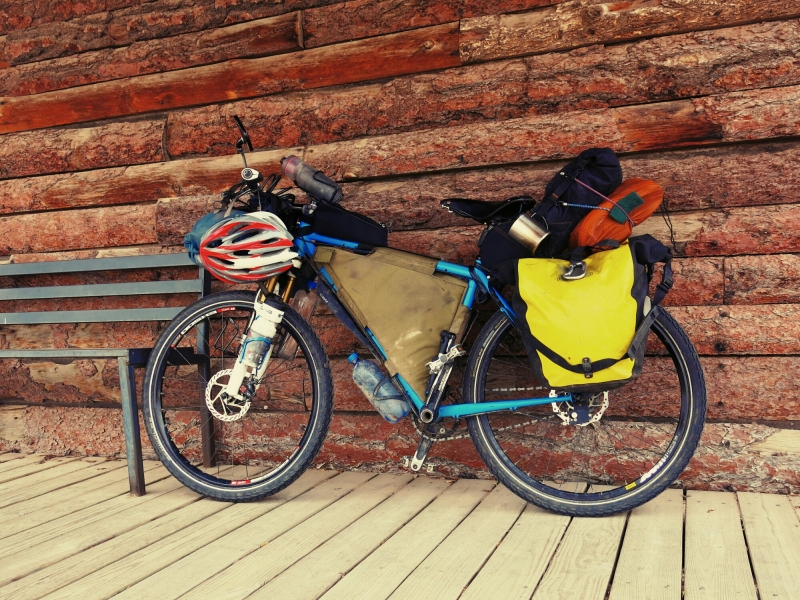Acero: 26″ cro-moly steel hardtail. He’s an expedition bike through and through. One of 15 bikes from the 2013 Stanford Frameworks class, Ace (for short) was designed and built specifically with this Americas trip on mind. Geometry and tubing choices (Columbus steel tubeset with Paragon Machine Works head tube) selected with a focus on climbing performance. Designed around the Rohloff Speedhub for ultimate transmission durability in all conditions.
Build decisions:
Wheel size: 26″. The main reasons to go with 26″ over a 29″ wheelset: increased wheel strength, greater availability of replacement parts. I’m not a very big guy, so the strength argument doesn’t concern me. I mainly went with 26″ wheels because I’ve never ridden a 29″ mountain bike before and didn’t want to build for something that unknown. At this point in the trip (currently in Peru), I don’t think the argument about the greater availability of 26″ parts is important. Throughout Latin America, at the very least 29er wheels can be found in bigger cities, and in less poor countries 29er parts are more common. Even 650b wheels are here. Notes for the future: Am planning on building a 29″ bike for future tours. While there’s really nothing wrong with 26″ wheels for me, knowing that 29″ wheels are out there and technically better at rolling/passive suspension makes them worth a try.
Transmission: Rohloff Speedhub, internally geared hub.
Instead of a standard cassette/derailleur setup, a Rohloff hub provides 14 gears fully protected from mud, dirt, snow, or anything else. Internally geared hubs are renowned for their reliability and durability; the downside is that if they do break, they’re essentially impossible to fix on the road. Acero does have dropouts with a rear derailleur hanger, so the Rohloff could always be switched out for a standard rear hub/cassette.
Platform pedals: Bit of an experiment. I am not a fan of walking around town in clipless shoes with the cleat clanking around. It’s definitely not something I want to put up with for an 18+ month tour. Starting in Alaska with a set of platform pedals gave me a chance to try out riding long-distances in flats again, with the option of switching back to a clipped-in system when I got back to the mainland US. Coming from clipped-in riding, riding in flats took a couple of weeks to get used to, but after that it becomes a non-issue. Having ridden now with other cyclists at similar fitness levels and bike weights, I would definitely say cycling performance is based much more on your daily energy level than the increased efficiency of clipless pedals over platform ones. Having said this, on a shorter tour I will probably go back to clipless pedals, and just put up with walking in cleats. No question that riding clipped in feels great. Notes for the future:
I would probably switch these Grip King pedals for a sealed bearing model with pegs. Haven’t done any maintenance on the Grip Kings in 21,500km, they’re due to have the bearings regreased soon, but in muddy conditions there’s a noticeable slipperiness to the pedals. Bikepacking generally involves muddy conditions at some point. Except for mud, the Grip Kings live up to their name.
Front suspension: 100mm Fox fork adds comfort on rough descents. If riding predominantly paved roads (thinking Canada, Central America), would go with a rigid fork over a suspension fork. But once the going gets tough, especially on 26″ wheels, having some bounce up front helps smooth out the ride. The Fox fork does have a lockout, and at a comparable weight to a rigid steel fork, it’s hard to say no to for a 26″ wheeled bike.
Build list:
Cockpit:
Handlebar: Salsa Bend2Bar, 23° sweep
Grips: Ergon GP1, small
Stem: 90mm, 10° rise Thomson Elite X4
Fork: Fox 32 CTD 100mm
Brakes: Avid BB7 Mechanical Disc, front and rear
Drivetrain:
Gears: Rohloff Speedhub
Rear cog: 16 tooth, Rohloff cog
Front chainring: 38 tooth, RaceFace Singlespeed
Chain: generic, 3/32″ width
Bottom bracket: 68mm, generic external cups
Cranks: 175mm RaceFace Turbine
Pedals: platforms, MKS Grip King
Seat:
Saddle: Brooks B17
Seatpost: 250mm Thomson Elite, no setback
Seatpost clamp: 29.8mm Thomson
Wheels:
Front: 32h 26″ DT Swiss EX 500 Disc rim, laced to DT Swiss 350 hub, 262mm DT Swiss Competition spokes
Rear: 36h 26″ Mavic XM 719 Disc, laced to Rohloff Speedhub, Sapim Race spokes
Tires: alternatively 2″ wide Schwalbe Mondials (Alaska to Ecuador), 2.25″ Schwalbe Big Bertha up front with 2.25″ Schwalbe Smart Sam in the rear (Colorado/Arizona), currently running 2.25″ Maxxis Ardents (Ecuador onwards). Briefly used a 1.6″ Schwalbe for paved Ecuador exit/Peru entrance.
Big thanks to Neil at CycleMonkey, Thomson, Schwalbe, Fox, DT Swiss, and Ryan, Scott, and Rob for their support.








What’s up,I read your new stuff named “The Bike: Acero | Steeling Away” like every week.Your humoristic style is awesome, keep it up! And you can look our website about love spells.